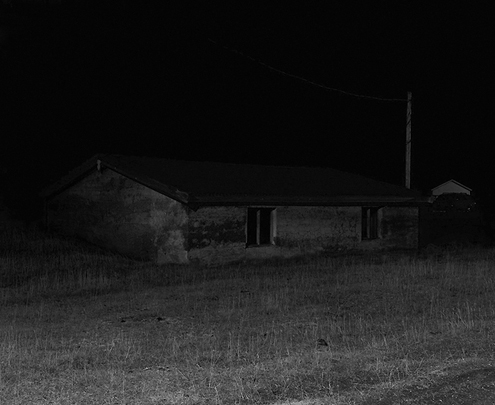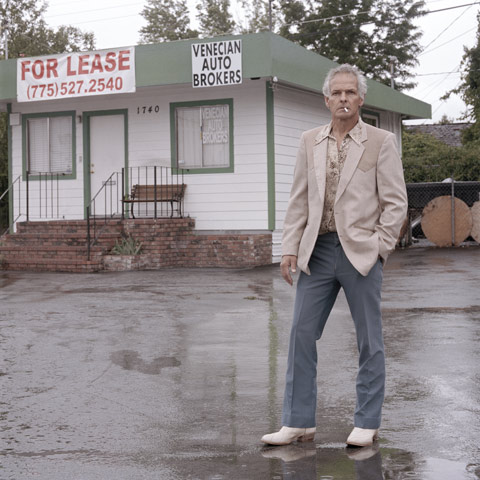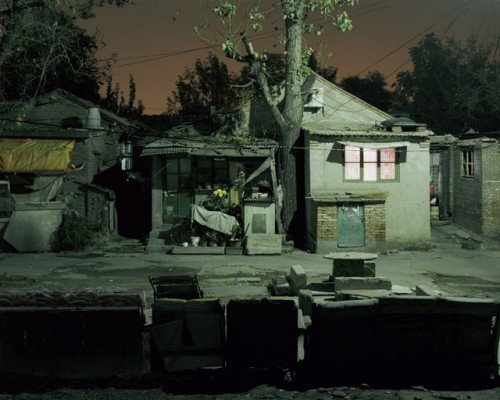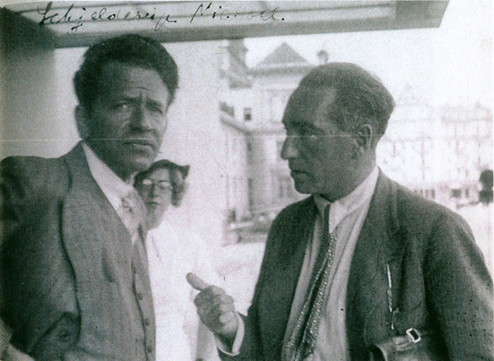
Manuel Alvarez Bravo
The photo above, from the great Maneul Alvarez Bravo, is one I’ve been looking at a lot this week. I can’t find where it was taken except that, obviously, it was Mexico. It reminds me a bit of Eisenstein’s Que Viva Mexico. And of that famous snapshot of Zapata and the U.S. Council. This is a world increasingly remote from our own. I think that is part of the sadness embedded in the above image.
“Satire? Call it instead a projection of existing givens—trends clear to those not already brainwashed, from escalation of war-making activities, counterrevolutionary in spirit and purpose, to the eradication of privacy of the individual on a global basis, and in-between, the stabilization of a world system of capitalism modeled in all particulars after that of America’s. GM, JPMorganChase, Boeing, Monsanto, these exemplify what the world can expect from corporate guidance in fashioning a well-regulated social order where everyone knows his/her place in a pecking order of Liberal Totalitarianism, the wave of the future! Should the world refuse this invitation to American-style happiness, contentment, and assured superiority, hierarchically arranged, by class, race, nation, then divine retribution would surely follow, God’s instrument being US military-financial-commercial power, poised On High, to vanquish all nonbelievers, via nuclear war in the face of stubbornness or ignorance.”
Norman Pollock
“So when I start to speak about conspiracy here, about propaganda, psyops and intelligence, I hope you will cut me some slack. We have to admit that there is a ruling class, that its purpose on this planet is to accumulate more capital at the expense of the workers. As we have seen, they will do anything to ensure this. … The folks with the tenured positions and six figure book deals have them for a reason, and it sure ain’t because they have a strong line on anti-imperialism.
Manyfesto blog, June 11th 2014
I was tangentially connected to the Left Forum panel of Ethan Hallerman and Molly Klein on Zizek. The attacks directed at this panel from people before even hearing what was said, were surprisingly large and aggressive. They were also from, a lot of them, these people with six figure book deals and a brand. Some were from the followers of those with six figure book deals. Most were white, and most were comfortable financially speaking. Or in some cases, just bitter half demented old white men who DESIRED to have six figure book deals. This is my experience today, when I go on facebook or twitter; a kind of growing hostility to speaking the obvious. The obvious being that the U.S. is working with proxy nations, and with sub contractors, to install a global police state. William Burroughs suggested that decades ago, and was laughed off as a crank. Remember Wilhem Reich was pilloried and denounced and prevented from continuing his research and eventually sent to prison. All of the facts are available, they aren’t secret or even hidden. They don’t have to be. The vast majority of people today in the West have been effectively trained to fear social shaming and stigmatizing. The fear of being laughed at is a gigantic factor in the willfull blindness and ignorance of the populations of the West.
I continue to believe that aesthetics and culture matter in all this. In fact I believe they are ever more important. In this era of the hegemony of corporate owned mass culture, it becomes vitally important to think seriously about how narrative and image and performance are manufactured, and how to approach them hermeneutically. The Obama Presidency has been essentially a movie. The grimacing death’s head sense of moral rictus is becoming more unsettling and I think as this becomes increasingly obvious, even to blinkered followers, there is a doubling down on the movie aspects.

Friederike von Rauch, photography.
“The more precisely my patients describe their behavior and experiences in the sexual act, the more firm I became in my clinically substantiated conviction that all patients, without exception, are severely disturbed in their genital function. Most disturbed of all were those men who liked to boast and make a big show of their masculinity, men who possessed or concurred as many women as possible, who could ”˜do it’ again and again in one night. It became quite clear that though they were erectively very potent, such men experienced no or very little pleasure at the moment of ejaculation, or they experienced the exact opposite, disgust and unpleasure.”
Wilhelm Reich
U.S. culture today is so awash in a hyper-masculine expressions of violence that almost everything, from sports to entertainment (sic) to shopping for food, clothing, and shelter, is defined by excessive masculine paranoia. And this interior terror and sexual insecurity clouds the vision of almost all young men in the West. Metaphorically and literally. And its not just the U.S., it is Europe, and probably beyond. Breaking down, deconstructing, this hyper masculine anxiety and often fear, of women mostly, is complicated, but I am more interested here to discuss the ways things are *not* seen because of these fears. And how much of this white male perspective is a form of blindness.

Awoiska Van der Molen
Among the best new photographers I’ve seen is Awoiska Van der Molen, and I’m posting a couple of her photos here. Almost every time I am struck with a photo, one taken in the last thirty years, it is almost always a woman photographer. I think because there is an additional layer of openness that is operative. It seems to happen most naturally in photography, and far less in fiction, say, or even painting. There are, of course, good woman painters today but the point is that something specific is being ‘seen’ in the photos. In Van der Molen there is a primal sense of invisible presence that comes out of the darkness. Most of her shots are taken at night. Sometimes in cloudy or foggy daylight, but most at night. Her work reminds me of George Ault a little bit. Huis Marsaille, the curator at the Museum of Photography in Amsterdam wrote this of her work:
“Her quest has something almost religious about it. For instance, it shares a conviction, along with spiritual, Christian and alchemist beliefs, that there must be a higher plane of ‘being’ to which mankind once had access, but with which contact is all but lost.”
I think this sort of description is going to come to most who really sit and look at her work. One critic wrote, “there is an absent presence”. Yes, exactly. Ghosts. The clarity of ghosts glimpsed, for ghosts are not indifferent, or undefined.

Awoiska Van der Molen
Adorno, in a lecture introducing his class on Negative Dialectics, wrote:
“I believe that what characterizes philosophical thinking is an element of the tentative, experimental and inconclusive, and this is what distinguishes it from the positive sciences.” But then he went on, a bit later, to say; “…the essence of this model of an antagonistic society is that it is not a society *with* contradictions, or *despite* contradictions, but by virtue *of* its contradictions. In other words, a society based on profit necessarily contains this division in society because of the objective existence of the profit motive. This profit motive which divides society and potentially tears it apart is also the factor by means of which society reproduces its own existence.”
The contradiction is not between concepts, but in the concept itself. This is crucial. For this establishes the world-out-there are an antagonist in a sense. In other words, concepts always point to something other, different from itself, and more than itself. Adorno uses the concept “freedom” in this lecture, which is, of course, a rather perfect example. But the point is that this character, a dual character of the concept, dialectically speaking, is connected to mastery. As Adorno writes toward the end of his introduction:
“..the mastery of nature, which spreads its influence, which continues in the mastery of men by other men and which finds its mental reflex in the principle of identity, by which I mean the intrinsic aspiration of all mind to turn every alterity that is introduced to it, or that it encounters, into something like itself and in this way to draw it into its own sphere of influence.”

U.S. Army press photo, appx. early 1950’s.

Adam Magyar
The profit motive, which is essentially Capitalism, creates a certain interior landscape. It’s been my experience that those who most resist the encouragements of propaganda, or approval from authority, and the people who will most find themselves excluded. Artists and radicals of all sorts. Those who learn how to integrate submission to authority, who fawn at authority, at power and displays of wealth and influence, are the ones who will become courtiers to the truly powerful. They find success, and this is true certainly in the arts today. But there is another aspect of this. The culture of masculine aggression seemlessly fits into a value system that looks for the concrete and uncomplicated answer. In fact, one that looks for answers in general. This is a mechanical kind of habit of mind. And it is about mastery.
Adorno touches on this when he says (in the same lecture): “Nowadays, in contrast to what Hegel criticized as abstract subjectivity or abstract negativity, what predominates in the general public is an ideal of abstract positivity…My eyes were opened to the dubious nature of this concept of positivity in emigration – where people found themselves under pressure from the society around them and had to adapt to very extreme circumstances. In order to succeed in this process of adaptation, in order to due justice to what they were forced to do, you would hear them say, by way of encouragement – and you could see the effort it cost them to identify with the agressor – ‘Yes, so and so really is so very positive’. And what is this means is that an intelligent and sensitive person is rolling up his sleeves and washing dishes, or whatever other allegedly useful social work is required of him.”
Today less effort, and perhaps no effort, is required to identify with the aggressor. TV and film is almost exclusively about the aggressor. But running alongside this is something that took hold, at least in this form, after WW1, and that is the idea of positive thinking. That positive was positive for its own sake. The bias toward the affirmative. The positive is going to trend toward aggreement. Consensus. This also coincides with that Protestant ethic of sober evaluation of facts. It’s Joe Friday: “just the facts”. It is the kindergarten level notion of constructive criticism. If you cant say anything nice don’t say anything at all. What that also means is, dont say anything NOT nice about authority. This is the creepy side of Nietzsche, the ‘say yes to life’ side! It is also, a kind of failure to examine the outlier, the aberration, the exception, as worth careful study. And this also becomes a value producing system that rewards NOT seeing. Compile data, but focus on the majority finding. Focus, crunch numbers, and do-not-look at the strange and unquantifiable, the anomaly. The patriarchal domination of a society of profit, has resulted in such a deep valorizing of this abstract “positivity”, and for “fact” based thinking, a society of primitive sociological thinking, of polls and data and pie charts. The male aggressor must constantly be re-inventing metaphors of contests, races, ‘winning’. So there is also a regressive nostalgia, a branded nostalgia where hunter gatherer societies all resemble Hollywood film. The primordial past becomes a spectacle.

Don Voisine
Photographers such as Awoiska Van der Molen, Friederike von Rauch, or Jennifer Garza-Cuen and others, are chronicling something that refuses this false positive. They shun the motifs of mastery. And this is an aspect of aesthetic education that seems seriously lacking. The negation of this ashistorical positive, both philosophically, as positivism, and also as the pop psychology of ‘positive thinking’, and smiley face stickers, has to take place primarily, or at least firstly, in form. For in a sense, the focus on content is itself a by-product of positivist and instrumental thought. Now I have to mention Adorno again here, for he said something in one of these late lectures that I find quite profound. He relates the story of a girl in one of his seminars, that he taught with Paul Tillich, right before the Third Reich took power. And how this girl voiced her opposition to the idea that life had some inherent meaning. Adorno describes the Nazi youth in this class becoming agitated at this, and rather excited and uncomfortable. He writes:
“It raises the question whether thought can bear the idea that a given reality is meaningless and that mind is unable to orientate itself; or whether the intellect has become so enfeebled that it finds itself paralysed by the idea that all is not well with the world.”
This is exactly what has happened in the ensuing fifty years, though no doubt through a somewhat different set of mental migratory patterns. The hegemonic thought of white male positivism, of false optimism, and sort of lubricated by various flood channels for aggression, and today that includes not just The Super Bowl, but white proto Imperialists like Zizek, or Doug Henwood, on the faux left, and Nick Land and Nial Ferguson or whoever, on the right, are the intellectual executors for a surplus unconscious. There is only a sort of vestigial dialectic operative at all in Western society today. For the prevailing positive is imbued with, or maybe just feeds off of, the nasty punitive moralistic residue of Cotton Mather and Jonathen Edwards. Why would leftists, purported leftists, attack any panel at the Left Forum ahead of time? That is the lynch mob. A cyber lynch mob. And it feels very like the specific tone of smallish white men who feel, in spite of themselves, inauthentic and masculine-challenged. For the entire fantasy anthropology of alpha male (the one reiterated by Elliot Rodger, or quoted mistakenly by clowns like Ted Nugent) is a powerful fantasy for white America, even for professors and the (sic) intelligensia.

Jennifer Garza Cuen, photographer.
Criticism itself is seen with distrust. Criticism must be *constructive*. Here intercedes this idea of reasonableness. Tone must be reasonable. So, if one grants this is true, then how does this false positive, this mock critical *constructive* posture, affect culture and artworks. My experience in theatre has been that, on the most crude level, it provides a platform for blindness. A teacher will point to what is good…ignoring what is bad, or encouraging the student to make this bad a little bit better. So the focus is to congratulate the student on what he or she has done well. And not dwell, and often not even mention, what is bad. Now the problem in narrative, and in theatre, is that one cannot really separate the bad from the less bad. It creates a imbalance, and suggests one not examine the organic totality of a work. It also, of course, suggests whatever the invisible forces might be, that its too subjective a topic for class time. Now its not as simple as demanding happy endings. Thats true, but less the point I think. It is this unremarked upon texture, the ineffable and fleeting. The uncanny. It is also the idea of clarifying. The ‘desire’ of young artists is sent through, today, a very odd psychological meat grinder with MFA programs, and before that, undergrad classes, and even back to high school, with how culture is examined. First of all, there is the subtle guilt of even taking part in art making. Guilt that one isn’t doing something more alpha male or serious, and then, well, is the goal going to be profit? For that is quite distinct for artists. The loss of clear categories, of definable meaning (like in the sciences) tends to result in a fetishizing of the remaining concepts, even if they are trivial or by their own definition, insignificant. The MFA environment is a place where ideas, in the arts, tend toward the reductive, for they are linked to specific pieces of art. A book, a play, a painting. There is, I suspect, a tension between the idea, the pursuit of something ecstatic or intuitive, and the demand for a grade, and by extension, a career. The meaning of great art is always so complex and contradictory, that it’s impossible to really ever define it. The prelude to personal growth, as an artist, is the baptism of failure, and of exile — in some way or other, that will allow a return. The growth required for the imagination to conceive grand visions is stunted by facile reassurance.

Magdalena Fernandez
Constructive criticism is the most destructive form of engagement with art. It is egotistical and arrogant and made worse when wrapped in tone of friendliness and supportiveness. Art is reduced to a bad 12 step meeting.
Identity, in this context, means ownership. This is what I describe here as the fetishizing of the inessential. If one can own this or that inessential idea, then everything else, every opinion, is anchored in this apriori landscape. I think that this idea of a kind of blindness is evident in a lot of the culture industry products, and in most mass culture. The backdrop to studio and network TV is quite simplistic. It extends to political amnesia, of course, too. But I’d like to argue that in architecture for example, much of the work of starchitects like Zaha Hadid or Rem Koolhaas, is missing something. There is a nagging sense of a needed part gone missing. Perhaps all elitist creation shares this type of absence. It is important to understand the presence of absence in, say, the photos of Van der Molen, and simply missing in a Hadid building. Of course performance art like Marina Abramovic is fetishizing this blindness and then selling it. Abramovic is to performance what Zizek is to theory and what Hadid is to architecture. And psychologically, the appeal of these public figures lies in the appearance of their proximity to power, and the allure of elitist sadism. It is a kind of social dominatrix theatre. The abdication of mastery means letting go of this artificial identity(s). Adorno said that the expectation of absolute certainty resulted in a muzzling of thought. The idea, the concept, cannot ever deliver what it promises. That expectation of certainty is linked, also, to mastery, and to ownership. And finally ownership to identity.Self mutilation is a syndrome that satisfies because of its absoluteness, and the ability to privately own that absolute. In other words, there is a backdrop of material social structures against which ideas appear.
“…it lies in the nature of society to produce the contents of the minds of human beings, just as it is the nature of society to ensure that they are blind to the fact that they mistake what is mediated and determined for actuality or the property of their freedom, and treat them as absolutes.”
Adorno

Ambrose Tezenes
Society has been trained to believe the surface is the entirety of life. As Jim Thompson said, ‘there is only one plot; things are not as they seem’. Today, this idea has been incorporated into ideology. The suspicion that things are not what they seem, becomes a flaw in ownership. The blindness of the white male, in a culture of power and profit, is another way of suggesting superficiality. But it is a specific form of superficial. The privileging of optimism does not mean that suffering is somehow more authentic. For of course, the superficially optimistic is a more acute form of suffering, and it is this realization that partly accounts for the increasingly spontaneous violence of 21st century America. Things are not as they seem, is responded to with a shrug, the shrug of the tyrant who will just step on and squash whatever it is that is destroying his perfect image.
Class creates certain psychological uniforms in today’s West. Especially the U.S. The happy face, cheerful, and smiling is the province of courtiers. The chatty world of the obviously unhappy, the defensive character armour of a vast working poor. And it extends of course to the idea of salesmen. The media promotes non-threatening versions of cheerful. Gender divides this, too. Women must be wholesome and cheerful, for the most part, and men must be reticent, and paternal, or avuncular, or simply militaristic. The poor are expected to be grateful. Apparently, that means grateful they aren’t in custody. Class has always had markers for easy identification. These markers are today, in the process of adjustment to electronic media. And in turn to self as brand. The ruling elite tend toward one uniform presentation of paternal authority. To watch TV figures interivew, say, Dick Cheney or Bill Clinton, is akin to watching a tier boss in D block listen to some fish explain why he cant pay his vig. This is the sado masochism of the fascists. And there are so many echoes, so many narrative fragments, lodged within all this. The Uncle who shows up, (Hitchcock’s Shadow of a Doubt), the bluff neighbor and his backyard barbeque, the fellow office workers, etc, and one begins to sense the near infinite permutations of bourgeois family dynamics, and the cliches that each have become in kitsch TV and film. Throughout, however, these surfaces themes, and characters, that express, as top text, the optimistic, are accompanied by the shadow unconscious, which is simultaneously expressed. The white male blindness. The blindness of the embedded Imperialist. In a way, the pathological villains of mainstream film and TV today, if not fiction as well, are outlets for the shadow white man, the blinded white patriarch. They kill and maim women, they steal and cheat, and even if they, in the narrative, are arrested, they remain the focal point. It is a subtle shift, and not just in depth and technique, from Iago to Hannibal Lecter, from Satan in Paradise Lost to The Joker in Batman. From Crime and Punishment to Wolf of Wall Street. In the former the crime is metaphysical, it has social resonance, and in the latter it is actually embraced, and the human casualties are ignored. The villains, the ‘bad guys’, in each episode are put away out of sight, at the end. The are consigned to invisibility.

Theophilus Brown
For even if there is a sense in white men that they are missing something, they have absorbed the values of Reagan/Thatcher/Rand and can tell themselves, well, I am the creator of my own life. I must rely on myself, and not let this mob of complaining poor get in my way. I will not let this troublesome union cheat me, etc. And the Reagan values are the values, at their core, of Capitalism. If you are a capitalist, you logically must applaud Reagan and Thatcher and in its essentials you applaud Bush and Obama. The answer to those who threaten your privilege is to stomp them out.
By the way, the Zizek panel can be listened to here:
https://www.youtube.com/watch?v=IrEJW3INm58#t=5440

Harald Sjeldrup, Nic Hoel, Wilhelm Reich. 1934

So much to chew on. How do we start to notice and eventually confront the shadows?
That’s great and thanks for the link.
I think that Adorno remark about inability to accept that things/aren’t right and indeed ordained is on to the heart if this here,so much reassurance that nothing is alarming, vicious attacks on any suggestion that anyone remains competent and free. Art that takes up decoding rep at her than creating is a symptom…it does criticism of nothing and no one while criticism becomes pathologized as impotent t railing against “the Others enjoyment”
But there is no more contrast between trivial and deep…just as cynicism and naivete have collapsed in these points of quantum irony. The obvious and the impossible too…that’s not a fascist junta, that’s not Hastings car explode…,its too obvious to be anything but occult…
Decoding rather than creating
About the volkishness of the emptiness and superficiality and triviality…its like Buffy yes? A performance of quotation of commodities …catechism of commodity consciousness.,,. and the confidence in the intelligibility of the brief signals, the shorthand references, is a gesture to the materiality if this volk constructed by Murdoch with infantile entertainments and the radical exclusion of all outside the reach of VICE in CAR and Madmen..
“ociety has been trained to believe the surface is the entirety of life. As Jim Thompson said, ‘there is only one plot; things are not as they seem” to the point of academic philosophy producing pseudoscience designating consciousness itself a “folk
” belief (a kind of “conspiracy theory” in social science)
@molly…………right, you should read Adorno’s lecture notes for Negative Dialectics. Its some of his best stuff and it really touches on all this. That volkish quality is embedded in so much of pop culture now. I was reflecting recently on Jacques tati…mon uncle…….this sort of critique of middle class vanities and illusions. Fast foward to Seth Rogan or Adam Sandler and one sees just far things have travelled.My next post sort of follows up a lot of this. But what you say about academic philosophy…..very true. Adorno said this nice thing about ‘expression’….that philosophy was a search for the right expression. That is utterly gone now. He said human beings were becoming ideology. The Buffy construct you describe, that is the refusal to believe our thoughts are mediated. Its the enacting of a performance of mediated codes, as you say, quotations. Everything is recuperating this litany of trivial mediation, of approved common sense cliche. Cliches are fetishized, and repeated and repeated and repeated.
I enjoyed reading this article and it’s many provocative points. I have observed and long felt that the culture within the United States is watering Art and Conversation down to a few symbols that are targeted toward, “White American,” that sends negative messages about: Mexicans, Chicanos, Latinos, Blacks, African-American, Women, Children, the Poor and Marginalized. It seems that most people drink this poison without a second thought, without questioning the intent behind these tailored messages. Just as I keep raising the question, “…Why are people/the Media/Government not talking about this surge of White Violence?” I’ve been called Racist for raising the question. Yet I continue to ask out loud.
Yeah,glorya…..white gun violence has spiked, but more disturbing is the lack of prosecution for any of it.
But as you say….look at two new TV series just out. Well, three actually. One is Bochco’s Murder in the First, the second if Gang Related, and the third is Last Ship.
all of them revere white authority, militarism, of police power, and all them tacitly blame the poor….except maybe Last Ship, but its doing something else……but the two cop shows are about dangerous inner cities and dangerous black or latino youth. Now in MITF the theoretical villain is a white silicon valley billionaire….but as you examine it more closely, other themes emerge, and it has all become so familiar by now, so formulaic, that yes, it passes without notice.